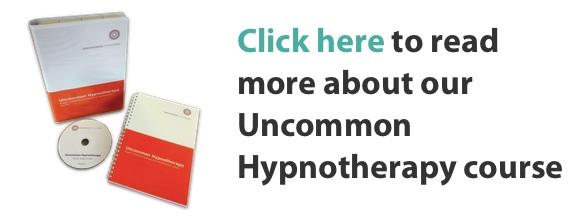Click below to listen to Roger and Mark discuss the concept of pattern matching and how to use it to help people…

If you would prefer to read this lecture, please see the transcript below:
Mark: Okay. So when you experience anything in life, then your brain tries to make sense of it by matching it to something similar in the past, to give you the right emotional response, and we call this a ‘pattern match’. So how useful or appropriate this match is will correspond with how mentally healthy you are.
So, on a very basic level, a newborn baby will pattern match a nipple to the instinct of suckling, and this is a good pattern match. A ‘sloppy’ pattern match will be if a baby pattern matched suckling to something that wasn’t a nipple, but was a bit like a nipple, such as a plastic teat on a bottle of milk. And we can see here that the pattern matching process needs to be sloppy so we can be adaptive in the world. But if there’s a ‘faulty’ pattern match, then the person has a problem. If you stick your finger in a baby’s mouth, then the baby may try and suckle on the finger, but of course it won’t get any milk from the finger; so this is a faulty pattern match – it’s not working for the baby.
Some pattern matches are hard-wired, such as the suckle response I mentioned with a newborn baby, and some are trained into us through what we’ll come to see as natural hypnotic experiences. Stage hypnotists like to produce faulty pattern matches for the amusement of the crowds, as when they, for example, hypnotise someone to produce the feelings of physical attraction for a broom or some other object.
Hypnotherapy – and, in fact, all types of psychotherapy – really seek to change unhelpful pattern matches to helpful and useful ones. Hypnosis is the best way of doing this because pattern matching itself is essentially a naturally hypnotic human process. And when we work with someone, we want to change a faulty pattern match, such as feeling sick with fear during public speaking, to a helpfully adaptive response, such as feeling calm and confident and ‘in the zone’ when talking in public.
Roger: Excellent. So we can see that pattern matching, in its simplest form, is an instinctive response to a trigger. And that trigger can be anything – from a spider, the scent of your favourite food, or a thought. Pattern matching helps us negotiate reality and works for our survival, while at the same time can cause us emotional complications through faulty pattern matches.
So now we’ll go back to Mark for an explanation of exactly what hypnosis is and how it involves the ‘rapid eye movement’ state of dreaming.
Mark: Okay. It’s a curious thing that many people who use hypnosis claim that it’s a mystery, that we still don’t know what hypnosis is. But actually, you’re going to learn exactly what it is.
Hypnosis happens when your REM state is triggered. Now, REM stands for ‘rapid eye movement’, which can be observed beneath the eyelids in a dreaming person; but the paradox here is that we can also experience REM outside of sleep. Sometimes you’ll observe the eyes flickering from side to side underneath the lids when you hypnotise somebody, so the same thing seems to be happening.
So let’s look at some of the similarities between REM sleep and what we might call ‘wakeful REM’, otherwise known as hypnosis.
One similarity between REM sleep and hypnosis is the experience of what we call ‘catalepsy’. Eyelid and body catalepsy occur in both sleep REM and hypnosis. So the eyelids, or even the whole body, can become cataleptic during hypnosis, which is one reason for those old black and white photos of hypnotised subjects being suspended, stiff as a board, between two chairs. It’s not a good idea to actually do that to somebody, but it can be possible with deeply hypnotised subjects, because they’re going deep into the REM state. What they’re experiencing is hypnotically-induced REM catalepsy. It also happens naturally, as when your clients may say they feel heavy after you’ve hypnotised them, or their hands feel numb.
The reason catalepsy happens when you dream at night is to prevent you acting out your dreams. The ‘anti-gravity’ muscles need to be inhibited so that they don’t move, so the body becomes very still; a kind of natural paralysis.
Another similarity between hypnosis and REM sleep, as I’ve mentioned, is the rapid eye movement itself. A direct way of inducing hypnosis was, traditionally, to swing a watch in front of someone to get them ‘REMing’ artificially.
Of course, another parallel is the activation of the imagination. When we’re in REM sleep, the imagination is fired absolutely and produces dreams. You might not think of that as your imagination working, but in reality, it is. And hypnosis will often produce very dreamlike experiences through the imagination in the mind.
And as we know, there’s a fast track way into hypnosis, as well, which occurs through the unexpected use of shock. So when something so unusual happens that for a split second, we can’t actually make a pattern match to it because there’s no precedent for such an unusual stimulus. Really, we can think of this as, you know, there’s a ‘meaning vacuum’. There’s no pattern match. Something very surprising or unexpected happens, you have no idea what’s going on, and the hypnotist may fill that meaning vacuum with a hypnotic command, which is more likely to be acted upon.
So you hypnotise someone in order to teach them something new, whether that’s how not to smoke or panic or whatever that might be. It’s really a learning mode that we’re getting someone into, even though they don’t always know they’re learning.
But why should it be that we learn so quickly through the REM state?
Well, curiously enough, most REM actually happens before birth, in the last three months that you spend in the womb. And it’s during this time that many of our instincts are laid down. So it makes sense, then, in order to learn instinctively, to re-enter the REM state during life to update emotional responses. And we do this by entering what we call hypnosis.
Roger: Okay, so to summarise: REM is a state where new instinctive templates can be created and old templates updated. And it’s accessed through shock, high emotion, hypnosis, or other highly focussed states.
Mark: Yes, and when your focus of attention narrows down on something – whether that’s a person or an idea or an expectation – then you instantly become more suggestible. So being suggestible simply means being more open to a type of learning.
And as Roger stated there, all emotions lock attention and also, when we experience them, they make us more suggestible, which is why the Uncommon understanding of emotional states is that they’re actually naturally occurring hypnotic states.
Roger: So when our attention gets locked, we enter a hypnotic state, and that can be for a few seconds or it can be for some time. And we can see that hypnotic states are available to us all the time, especially when someone is focussed through emotion, pain, or deep relaxation.
Now we’re going to look at how we actually hypnotise and examine the phenomenally useful principle of utilisation.
Mark: An Uncommon hypnotist – which is what you’re going to be – is able to use whatever the subject brings to the situation. This is called the ‘utilisation principle’. So rather than always having to inflexibly work from preset inductions or – even worse – read a script to someone, we can creatively tailor our approach to the unique person in front of us.
For example, today I hypnotised a woman by re-evoking the experience of her learning to ride a bicycle, because she found the experience so positive. It was a tailored, personal, individual hypnotic induction.
So rather than always having set inductions, we can actually make a hypnotic induction out of anything, as long as it appeals to the person being hypnotised.
One of the easiest and most rapport-building ways to hypnotise is simply to re-evoke a positive experience that your client has had at some point that they’ve told you about. When you re-evoke an experience hypnotically through your imagination, your body will start to access the way it actually felt in the original time.
So if we look at it from perhaps a more negative perspective, if you recall a time that you felt very angry, your blood pressure will actually rise, even though you’re no longer in the original anger-inducing situation – and this actually is a hypnotic effect. And if someone strongly recalls in hypnosis being very relaxed on a warm beach, maybe the summer before, their skin temperature will rise (perhaps because it was a lovely warm day), their immune function will improve because it works better when they relax, and their body and mind will align itself back to that pleasant experience. So your body to some extent follows what your mind does, as far as hypnosis and imagination is concerned.
And because it’s an experience they had, then it will be easier for them to access. So we’re utilising their experience, we’re not trying to get them to experience something they may never have experienced before, which is what a lot of inductions try to get people to do.
So this principle of using whatever the subject enjoys or has enjoyed forms the basis of the first ‘free flow’ induction that you see on the DVD, [Disc 1, Section 3]. The important thing is that you’re flexible and adaptive, because these traits allow you to be much more effective as a hypnotherapist.
Roger: Okay. So now you can begin to see how these three things fit together:
- How the unconscious mind produces pattern matches
- How this connects to the REM state
- How we can utilise people’s individual experience to produce effective hypnotic experiences for them.
Now we’re going to move on to the specific ways in which you communicate to actually induce hypnosis…










